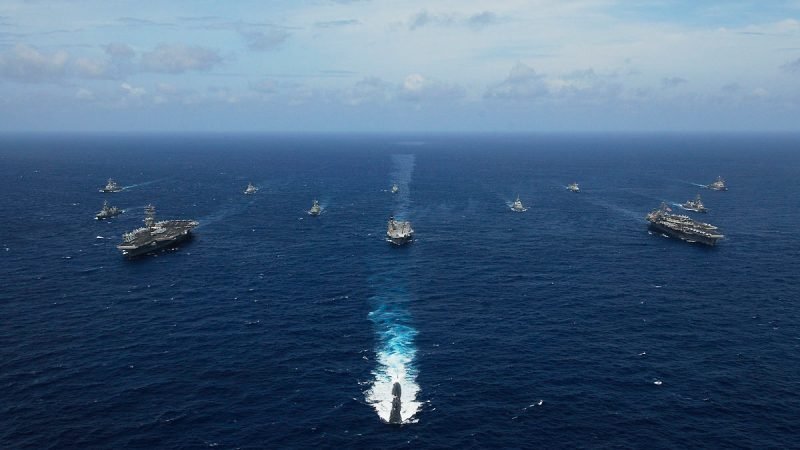India’s Maritime Engagement with ASEAN

Maritime cooperation is one of the significant aspects of the India-ASEAN strategic partnership. India’s naval affiliation with the Southeast Asian nations is an imperious dimension of the “Look East Policy”, introduced in the early 1990s. India-ASEAN relations have improved incrementally with India becoming the ASEAN Sectoral Dialogue Partner in 1992, and a full Dialogue Partner as well as a member of the ASEAN Regional Forum (ARF) in 1996. Today India ASEAN relations stand at an ecstatic stratum of a strategic alliance.
It must be noted that India’s naval affiliation with the ASEAN nations dates back to the early 1990s. ASEAN nations have embraced Indian mien in the region and wish to see India follows its assignations. Both sides have procured the significance of India-ASEAN cooperation. Indian Prime Minister Manmohan Singh underlining the need to further accentuate ties remarked in May 2013 that “…ASEAN countries are our strategic partners and there are enormous opportunities of expanding trade ties, expanding investment relations, expanding maritime cooperation, expanding the scope of trade and investment. And now we have reached a stage where the large-scale flow of trade and investment is becoming a reality…”. Although India and its ASEAN counterparts may not have yet procured the full potential of their naval collaboration, there has been additive advancement on this front over the years.

A Quick look on the Engagement History
India has been an active member in the assignation with the ASEAN countries. Maritime Collaboration and Naval goodwill visits are important aspects of defence diplomacy. Defence engagements are pivotal to build and purport trust and contribute toward conflict prevention and resolution. In this, India and ASEAN share common platform wherein both parties seek to purport peace and security in the region. This was reflected by the Vision statement adopted at the India-ASEAN commemorative Summit 2012, which emphasizes the significance of maritime security. “We are committed to strengthening cooperation to ensure maritime security and freedom of navigation, and safety of sea lanes of communication for unfettered movement of trade in accordance with international law, including United Nations Convention for the Law of the Sea (UNCLOS)” stated the Vision Statement, accenting the main issues in the South China Sea namely freedom of navigation and the need to hew to international rules and norms.
India has been engaging through joint exercises, Naval goodwill visits and military drills with the Southeast Asian nations for a long period of time. India has strengthened its naval affiliation with the ASEAN nations and seek to further accentuate its defence collaboration with the countries.
As we talk of India and Brunei, both the countries adore a high degree of commonality in their discernments of major international issues. Brunei has been supportive of India’s earlier ‘Look East Policy’ and also the present ‘Act East Policy’ and in accumulation and enhancing of collaboration with ASEAN. Common membership of UN, NAM, Commonwealth, ASEAN etc. and as countries with good traditional and cultural ties, Brunei and India have close relations. Over the past several years, the relations and cooperation between the two countries in the area of defence has been accumulating. This includes regular official level defence exchanges, visit of naval and coast guard ships, training and joint exercises and participation in each other’s defence exhibitions/expositions etc. There are several engagements such as visits of Indian Navy Ships to Brunei: Indian Coast Guard Ship ICGS ‘Shaunak’ on 09-12 January 2019 and visit of Royal Brunei Navy Ships to India: A Bruneian ship, ‘KDB Darulaman’, participated in MILAN 2012 (Andaman); and Royal Brunei Navy’s Ship ‘KP 80 DARU TTAQWA’ visited India (Mumbai) in August 2014.
On the part of India and Myanmar, both sides have an accord on Maritime Security Cooperation covering Maritime Domain Awareness and signed a White Shipping Agreement. Prime Minister Modi visited Myanmar from 5-7 September 2017, when he visited Nay Pyi Taw, Yangon and Bagan. 11 MoUs/ Agreements including the MoU on Maritime Security was signed during the visit.

In the case of India and Indonesia, Both sides have shared two millennia of close cultural and commercial contacts. The shared culture, colonial history and post-independence goals of political sovereignty, economic self-sufficiency and independent foreign policy have a unifying effect on the bilateral relations. The two leaders also met on the sidelines of G-20 Summit at INTEX Osaka, Japan on 29 June 2019 where they discussed about deepening of economic and maritime collaboration between the two countries.
India and Cambodia adore warm and genial relations. There exists bounteous of goodwill for India in Cambodia, which has been endured by regular interactions of political leaders, exchange of bilateral visits, aid and assistance, capacity building, cultural exchanges, concessional loans for developmental projects and restoration & conservation of old temples in Cambodia. In the context of Maritime Cooperation, the interaction between India and Cambodia is limited i.e. goodwill visits by Indian Navy and Indian Coast Guard ships and exchange of official delegations.
On the part of India and Malaysia, both the countries adored a strong relationship in the 1960s as a result of the personal friendship between Prime Ministers Nehru and Tunku Abdul Rahman Putra. PM Abdullah Badawi (2004-2009) took some important initiatives to hammer out a closer relationship with India. This trend was strongly reinforced by PM Dato’ Seri Mohd. Najib Tun Abdul Razak. Presently, India and Malaysia have developed close political, economic and socio-cultural relations.
In the case of India and the Philippines, both Sides formally established diplomatic relations on 26 November 1949, shortly after both countries gained independence [the Philippines in 1946 and India in 1947]. High-level visits and interactions between India and the Philippines have seen intensification especially since the induction of ASEAN-India Summit level partnership and establishment of East Asia Summit, of which India is a founding member. India participated in a security dialogue with the Philippines in 2003 and institutionalized the Joint Defence Cooperation Committee in 2012
The year 2017, in particular, was marked by unprecedented high-level exchanges culminating in the visit of Prime Minister Narendra Modi to the Philippines to attend the 31st ASEAN and EAS Summits in Manila from November 12-14, 2017.
The Philippines also participated in the Def-Expo in April 2018. Indian Navy and coast guard ships regularly visit the Philippines and hold consultations with their counterparts. On 1st February 2019, ICGS Shaunak visited Manila on the occasion of Indian Coast Guard Day. Indian Navy Vessel, INS Rana (D52) visited Manila from 23-26 October 2018. ICGS Shaurya visited Manila from December 1-5, 2017 and INS Satpura and INS Kadmatt visited Manila from 3-6 October 2017.
And India and Singapore added new momentum and direction in their Strategic Partnership in 2018, anchored in the Official visit of PM Modi to Singapore from 31 May-2 June and his second visit on 14-15 November for attending the ASEAN-India and related Summits. Singapore’s Participation in Indian Ocean Naval Symposium and multilateral Exercise MILAN hosted by Indian Navy. Singapore’s membership of Indian Ocean Rim Association (IORA) and India’s membership of ADDM+ (ASEAN Defence Ministers’ Meeting – Plus) furnishes the platform for both countries to coordinate positions on regional issues of mutual perturbation. New developments include the inaugural Trilateral Maritime Exercise between India, Singapore and Thailand (SITMEX), announced by PM Modi in his Keynote address at the 2018 Shangri La Dialogue in September 2019 in Andaman Sea with the pretension to regulate it annually at alternative locations. Indian Naval Ship Sagardhwani visited Singapore in August 2019 to promote scientific cooperation between Indian agencies including DRDO and Singaporean agencies. The two sides agreed to strengthen maritime information exchange, intensify Humanitarian Assistance and Disaster Relief (HADR) cooperation, explore collaboration in areas like geospatial data, cybersecurity and setting up of Joint Test Facilities under the Defence Testing Infrastructure Scheme of India.
In the case of India and Thailand, Both the countries, located in each other’s extended neighborhood, share a maritime boundary in the Andaman Sea. India’s bilateral relations with Thailand are rooted in history, age-old social and cultural interactions and extensive people to people contacts. They cooperate closely in the ASEAN, East Asia Summit (EAS) and Bay of Bengal Initiative for Multi-Sectoral Technical and Economic Cooperation (BIMSTEC) groupings as also in Mekong Ganga Cooperation (MGC), Asia Cooperation Dialogue (ACD), Indian Ocean Rim Association (IORA) and Ayeyawady-Chao Phraya-Mekong Economic Cooperation Strategy (ACMECS). The other ongoing defence cooperation initiatives comprises of bi-annual joint maritime patrolling by the navies of both countries, annual staff talks, subject matter expert exchange visits and training of officers at each other’s institutions.

And India and Vietnam, with historical roots in the common struggle for liberation from colonial rule and the national struggle for independence, share traditionally close and genial bilateral relations. There are several instances which show the strong relationship of both the countries such as the address by the Indian President in Hanoi on 20 November 2018 when he stated: “The ocean system is a resource for Vietnam and India … (They) share a vision for the Indo-Pacific region …. India looks forward to enhanced bilateral cooperation in the maritime domain.” And India-ASEAN dialogue on Blue Economy was coordinated by Vietnam on behalf of ASEAN. At the second workshop in Delhi in July 2018, a senior Indian official stated that this realm had “tremendous scope” for cooperation.
In a nutshell, With strategic hassle in South Asia shifting to the maritime domain and nuclear weapon states increasingly relying on sea power, Maritime domain has become a theatre for security competition between major powers. The increasing assertiveness in the maritime domain makes it necessary for New Delhi to maintain its stakes and safeguard its interests in the region. This, in turn, will necessitate continued naval assignation with the littorals. India can be a key player in purporting peace and security in the maritime domain and for that New Delhi must further enhance its maritime cooperation with the Association for the South East Asian Nations.


















